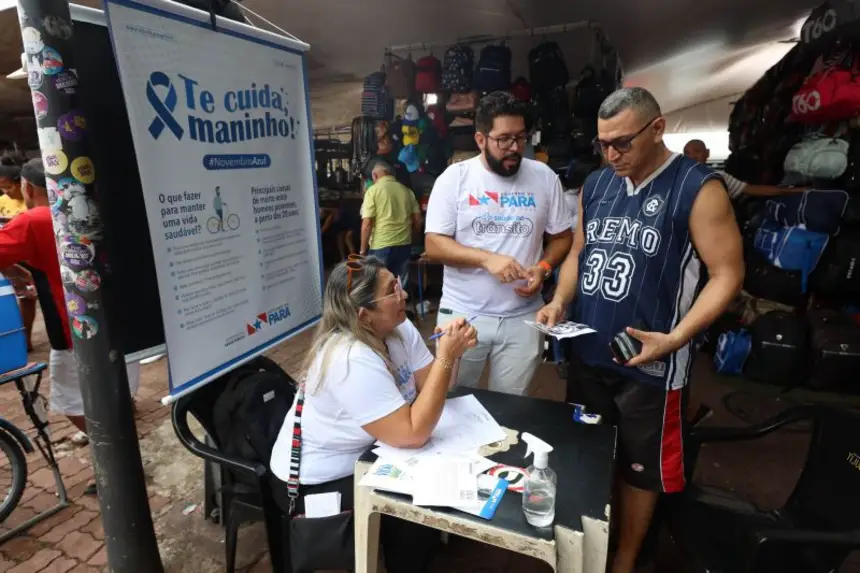On National Men's Day, Sespa draws attention to men's health care
The State Department of Public Health (Sespa) presents the main services and strategies that the Unified Health System (SUS) offers for men

On this Tuesday (15), which is celebrated as National Men's Day, the State Department of Public Health (Sespa) presents the main services and strategies that the Unified Health System (SUS) offers for Brazilian men, as well as an overview of the health status of the male population in Pará.
The commemorative date was established in 1992 by the National Writers' Order as a way to draw the male population's attention to health care. The International Men's Day, with the same objective, is celebrated on November 19.
According to Andrei Porpino, a technician from the State Coordination of Men's Health, in Brazil, men live, on average, seven years less than women, mainly because they are the main responsible for cases of interpersonal violence and suicides, are more involved in traffic accidents, consume more cigarettes and illicit drugs, and seek health services less than women. "Generally, when men seek a health unit or hospital, the disease is already established, requiring more specialized resources," he said.

Andrei Porpino assures that many diseases can be prevented if men seek health posts and family health teams more frequently. Because, in these places, they have access to routine consultations and exams, vaccination, rapid testing for sexually transmitted infections (STIs) (HIV, syphilis, and hepatitis B and C), dental treatment, dressings; medications and guidance.
According to some scientific studies, there are several factors that contribute to men not seeking health units. Among the individual and sociocultural factors are the fear of discovering some disease, shame of exposing the body to a health professional, the habit of procrastination, machismo, and aversion to any idea of showing "weakness."
Other causes include the operating hours of health units, not being released from work to take care of their health; believing that health programs and preventive actions are only for women, children, and the elderly.
To facilitate and increase men's access to health services and thus reduce the high rates of mortality and hospitalization, the National Policy for Comprehensive Men's Health Care (PNAISH) was established in 2009, which prioritizes men aged 20 to 59, without disregarding other life cycles (children, adolescents, and the elderly). The PNAISH is divided into five axes:

• Access and reception: to sensitize health professionals to seek and keep male users in primary health care units (health posts), preventing the onset of diseases that can only be cured in specialized care (hospitals).
• Prevention of accidents and violence: to guide actions aimed at reducing deaths and hospitalizations due to external causes (interpersonal violence, transport accidents, workplace accidents, and suicides).
• Prevalent diseases in the male population: to act in the prevention and promotion of health through educational actions, organization of services, and training of health professionals. Among the main ailments, chronic non-communicable diseases (hypertension, diabetes, kidney failure, and cancer) deserve special attention.
• Sexual and reproductive health: to promote the prevention of STIs, ensure the observation of sexual and reproductive rights, and disseminate family planning.
• Fatherhood and care: to prepare men for participatory and responsible fatherhood. In this axis, we have the Partner Prenatal Strategy.
Partner Prenatal - Inspired by successful experiences spread across Brazil, the Partner Prenatal Strategy (EPNP) was established in 2016 by the Ministry of Health, aiming to implement the "Fatherhood and Care" axis of the PNAISH, aiming to stimulate men's active participation in all actions of family planning, pregnancy, childbirth, postpartum, and child development.

This Strategy prepares men for responsible and active fatherhood, in addition to increasing male access to health services at health posts. The future father undergoes multiprofessional consultations, routine exams, rapid tests for STIs, gets vaccinated, and participates in educational activities.
"It is worth remembering that the EPNP is not aimed only at biological and heterosexual fathers. It also includes socio-affective fathers, homosexual, trans, and solo fathers (those who have adopted a child alone)," emphasized Andrei Porpino.
He stressed that it is important for primary health care professionals to be prepared to welcome the couple, explain the importance of partner prenatal care, clarify doubts, and disseminate the service to users, with the participation of community health agents. "Our guidance is that men seek the health post closest to their home," he said.
Male morbidity and mortality - According to Andrei Porpino, an interesting fact is that until 2023, in the state of Pará, the male population was larger than the female population; however, in 2024, this situation changed, and today, 50.01% of the Pará population are women and 49.99% are men. Only four states still have more women than men in their population: Acre, Tocantins, Roraima, and Mato Grosso. "This is partly due to higher male mortality across all age groups, but especially in adulthood, where external causes, such as accidents and violence, are more frequent among men," he informed.
"Population aging also contributes to the higher proportion of women, as they tend to live longer than men. The trend of gender ratio reversal, with women becoming the majority, has intensified in recent decades in Brazil and Pará, following a global pattern of increasing female life expectancy," added the health professional.
Regarding the main causes of male deaths, Andrei Porpino cited chronic non-communicable diseases (hypertension, diabetes, kidney failure, and cancer) as the leading killers, but which can also be prevented by adopting good habits. "It has been very common for young men to present cases of heart attacks and strokes. The main reasons for this sad reality are the consumption of processed and ultra-processed foods, sedentary lifestyle, lack of routine exams for the detection of chronic non-communicable diseases, and daily stress," he explained.
External causes are also responsible for high rates of male deaths and hospitalizations, especially in this age group. The following ailments are classified as external causes: fractures, trauma, perforation, strangulation, asphyxia, burns, drowning, and poisoning, resulting from interpersonal violence (physical aggression), traffic accidents, and suicide.
From 2023 to the present, the causes of male deaths are distributed as follows: diseases of the circulatory system (25.49%), external causes (18.95%), malignant tumors (12.62%), diseases of the respiratory system (10.87%), infectious and parasitic diseases (5.75%), diseases of the digestive system (5.30%); endocrine, nutritional, and metabolic diseases (5.23%) and diseases of the genitourinary system (3.18%).
Behavior - To give an idea of men's behavior regarding health care, Andrei Porpino presented a comparison of attendances between the female and male populations. In Pará, 56% of the male population is aged between 20 and 59 years, which corresponds to adulthood, a period characterized by various phases and challenges. It is the stage of life when many men are establishing their careers, forming families, and facing financial responsibilities.
This age group is also an important focus for men's health, with special attention to disease prevention and promotion of healthy habits. However, the data shows that men are still not seeking medical care as they should. In both 2023 and 2024, of the total consultations in Primary Care, 63% were made by women and only 37% by men. "This disparity in numbers has been greater, indicating that the implementation of the PNAISH in the municipalities of Pará has generated good results," said Andrei Porpino, adding that Sespa has sought greater balance between the two genders within APS.
Mental and emotional health - In conclusion, Andrei Porpino said that men's mental health is a topic that deserves increasing attention because social stigmas can lead men to suppress emotions and not seek support for issues such as depression, anxiety, and stress. This suppression can have serious consequences, such as an increased risk of substance abuse and, in extreme cases, suicide. Therefore, promoting an environment where men feel comfortable expressing their feelings and seeking professional help, whether with psychologists or psychiatrists, is vital for overall male well-being. "Taking care of health is an investment for the future, ensuring more quality of life and longevity. Breaking the silence, deconstructing prejudices, and prioritizing self-care are fundamental steps for men's health to be seen and treated with the importance it truly deserves," he concluded.









